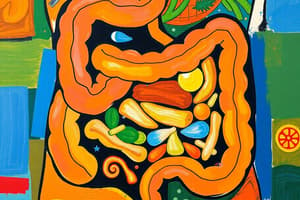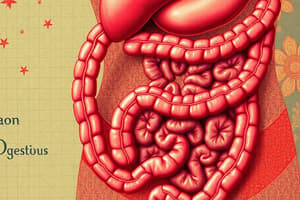Podcast
Questions and Answers
What is the primary function of the salivary glands in the digestive process?
What is the primary function of the salivary glands in the digestive process?
- To absorb nutrients from digested food
- To produce saliva containing enzymes (correct)
- To produce bile for fat digestion
- To mechanically break down food
Which section of the small intestine is primarily responsible for the receipt of secretions from the pancreas and liver?
Which section of the small intestine is primarily responsible for the receipt of secretions from the pancreas and liver?
- Jejunum
- Ileum
- Duodenum (correct)
- Cecum
What is the main role of the large intestine in the digestive system?
What is the main role of the large intestine in the digestive system?
- Chemical digestion of fats
- Mechanical breakdown of food
- Production of digestive enzymes
- Absorption of water and electrolytes (correct)
What are the three sections of the small intestine?
What are the three sections of the small intestine?
Which digestive process involves the use of enzymes to break down food into its chemical components?
Which digestive process involves the use of enzymes to break down food into its chemical components?
What is a primary function of the integumentary system?
What is a primary function of the integumentary system?
Which organ system is primarily responsible for gas exchange in the body?
Which organ system is primarily responsible for gas exchange in the body?
What role does the skeletal system play in the human body?
What role does the skeletal system play in the human body?
Which system is involved in the production of hormones and regulation of metabolism?
Which system is involved in the production of hormones and regulation of metabolism?
What is a main function of the circulatory system?
What is a main function of the circulatory system?
Flashcards are hidden until you start studying
Study Notes
Gastrointestinal Tract (GI Tract)
- The mouth is where food enters the digestive tract.
- Teeth and the tongue break down food mechanically.
- Saliva, produced by salivary glands, contains enzymes that start the chemical breakdown of carbohydrates.
- The pharynx is a passageway for food from the mouth to the esophagus.
- The esophagus is a muscular tube that uses peristalsis to move food from the pharynx to the stomach.
- The stomach churns and mixes food with gastric juices, containing hydrochloric acid and enzymes, and is divided into four sections: cardia, fundus, body, and pylorus.
- The small intestine is the longest part of the digestive tract with three sections: duodenum, jejunum, and ileum. It receives secretions from the pancreas and liver, and is the primary site for chemical digestion and nutrient absorption.
- The large intestine absorbs water and electrolytes. It also houses bacteria that produce vitamins like vitamin K and biotin. The large intestine consists of the cecum and appendix, as well as the colon (ascending, transverse, descending, sigmoid).
- The rectum stores feces.
- The anus is where feces are released.
Digestive Glands
- Salivary glands produce saliva containing enzymes.
- The liver produces bile, which aids in fat digestion.
- The pancreas produces enzymes for carbohydrate, protein, and fat digestion.
Digestion Process
- Mechanical digestion breaks down food physically into smaller pieces.
- Chemical digestion breaks down food chemically using enzymes.
- Steps in digestion: intake of food and water, passage of food through the GI tract, mechanical breakdown of food, chemical breakdown of food, absorption of digested nutrients, vitamin K and biotin production by bacteria, and removal of waste products.
Food Components and their Roles
- Carbohydrates provide energy and maintain body function.
- Proteins are essential for body growth, tissue repair, and enzyme & hormone production.
- Fats provide energy, regulate body temperature, and contribute to cell membrane structure.
- Vitamins are essential for growth, development, and improving immunity.
- Minerals are building blocks for teeth, bones, muscles, nerves, and blood.
- Water hydrates cells, regulates metabolic processes, and acts as a universal solvent.
Time taken for Digestion
- Mouth: 5-30 seconds
- Stomach: 2-24 hours
- Small Intestine: 3-5 hours
- Large Intestine: 1.5-2 days
Types of Food and Digestive Enzymes
- Carbohydrates are broken down by amylolytic enzymes (e.g., ptyalin, amylase, maltase, sucrase) into glucose.
- Proteins are broken down by proteolytic enzymes (e.g., pepsin, trypsin, chymotrypsin, aminopeptidase) into amino acids.
- Fats are broken down by lipolytic enzymes (e.g., gastric and intestinal lipase, phospholipase, cholesterol and glycerol esterase, lecithinase) into fatty acids and glycerol.
Digestive Tract
- The digestive tract is 8-10 meters long and transports approximately 11.5 liters of digested food, fluid, and digestive juices daily.
Mouth & Buccal Cavity
- The vestibule is the part of the mouth surrounded by the lips.
- The buccal cavity is the cavity behind the mouth, enclosed by the upper and lower jaws.
- Components: Teeth, Gums (Gingiva), Tongue, Palate.
- The palate is divided into a hard palate (anterior two-thirds) and a soft palate (posterior one-third).
- Teeth are embedded in the alveoli in the upper and lower jaws. Adults have 32 teeth, while children have 20 baby teeth.
- Diphyodont: Teeth erupt twice (baby teeth, then permanent teeth).
- Thecodont: Teeth are embedded in sockets in the jawbones.
- Heterodont: Different types of teeth are present: incisors, canines, premolars, and molars.
Tongue
- The tongue plays a crucial role in taste perception, mechanical digestion, and speech.
- It contains taste buds that detect different tastes (sweet, salty, sour, bitter).
- The tongue helps manipulate, mix, and form a bolus of food to aid in swallowing.
The Pharynx (Pharynx)
- Shaped like a funnel, the pharynx is a common pathway for food and air.
- It has three parts: nasopharynx, oropharynx, and laryngopharynx.
- The epiglottis prevents food from entering the trachea during swallowing.
The Esophagus (Oesophagus)
- The esophagus is a highly muscular part of the alimentary canal, extending from the pharynx to the stomach.
- It moves food to the stomach through peristalsis.
The Stomach (Stomach)
- Located in the upper abdomen below the diaphragm, the stomach has several parts: cardiac orifice, fundus, body, pylorus, greater curvature, lesser curvature, and sphincters.
- The stomach temporarily stores food.
- Stomach Capacity: Newborn (30 ml), Adolescent (1 litre), Adult (1.5-2 liters).
Small Intestine
- Extends from the stomach's pyloric sphincter to the ileocecal/ileocolic sphincter at the start of the large intestine.
- Divided into three sections: duodenum, jejunum, and ileum.
- The small intestine's wall has five layers: serosa, muscularis, submucosa, muscularis mucosa, and mucosa.
- The small intestine wall has numerous finger-like projections called villi.
- Digestion in the Small Intestine:
- Mechanical digestion: acid neutralization, lubrication, protection of the small intestine wall, pH regulation, segmentation, peristalsis, and emulsification.
- Chemical digestion: carbohydrate digestion, protein digestion, and fat digestion.
Carbohydrate Digestion
- Salivary Amylase acts on cooked and raw starches, while pancreatic amylase acts on cooked and raw starches but is absent in infants up to 6 months old.
- Intestinal Amylase also acts on cooked and raw starches.
Protein Digestion
- Pancreatic Enzymes: trypsinogen, chymotrypsinogen, trypsin, chymotrypsin, carboxypeptidase, aminopeptidase, tripeptidase, dipeptidase, collagenase, elastase.
- Intestinal Enzymes: enterokinase, erepsin.
Nucleic Acid Digestion
- Intestinal juice contains enzymes (deoxyribonuclease [DNAase] and ribonuclease [RNAase]) that digest DNA and RNA into mononucleotides.
Digestion of Fats
- Pancreatic juice breaks down fats into fatty acids, glycerol, and phosphoric acid.
- Intestinal juice further breaks down fats into monoglycerides and fatty acids.
- Lipase converts both fats and monoglycerides into fatty acids and glycerol.
- Phospholipase breaks down phospholipids.
- Cholesterol esterase breaks down cholesterol esters.
- Lecithin breaks down lecithin.
Intestinal Enzymes
- Nucleic acids are broken down by nucleoid, nucleotidase, and nucleosidase enzymes in the intestinal glands.
- These enzymes break down nucleic acids into phosphates, pentose sugars, and nitrogen bases.
Digestive Tract Diseases
- Structural disorders: Problems with the structure of the digestive tract.
- Functional disorders: Problems with the function of the digestive tract.
- Examples of digestive diseases: IBS, SIBO, GERD, gallstones, celiac disease, Crohn's disease, and ulcerative colitis (UC).
Anatomy and Physiology
- The anterior side of the body is the front of the body
- Lipolytic enzymes break down lipids
- Goblet cells are present in the mucosa layer of the small intestine
- Ptyalin is an enzyme found in the salivary glands
- Trypsin is an enzyme that helps with protein digestion
- An adult has 16 teeth in their lower jaw
Studying That Suits You
Use AI to generate personalized quizzes and flashcards to suit your learning preferences.




